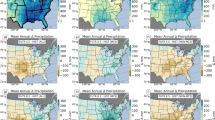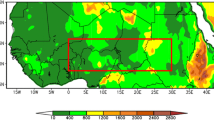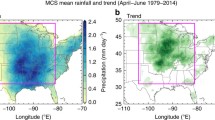Abstract
Twenty years of IMERG precipitation estimates are used to evaluate the contributions of mesoscale convective system (MCS) rainfall to total rainfall in the Congo Basin. Studying these systems advances our basic understanding of Congo Basin rainfall on all time scales. The seasonality of MCS rainfall in the Congo Basin follows the seasonality of total rainfall with high rainfall in spring, summer, and fall and a winter dry season in each hemisphere. In the equinoctial seasons, MCS rainfall accounts for ≥ 80% of total rainfall within 5° of the equator with the highest rainfall rates occurring along the eastern and western boundaries of the basin. In boreal summer, MCS rainfall maxima occur near the Cameroon Highlands (9°–18°E) and in boreal winter, they occur along the eastern orography (22°–28°E). The 80% percent contribution is sustained in the continental interior (15°–25°E, 5°S–5°N) throughout the year. The diurnal cycle of MCS rainfall is similar to that of total rainfall. Diurnal cycles are unimodal in the equinoctial seasons but are regionally and seasonally inhomogeneous in the solstitial seasons. Regardless of modality, MCS rainfall is highest at 15Z (1600/1700 LT) and lowest at 10Z. MCS percent contribution changes little throughout the diurnal cycle but is highest (≥ 90%) at 04Z close to the continental interior. Larger MCSs contribute their greatest percentage of MCS rainfall (83–92%) between 04Z and 07Z, while more-intensely precipitating MCSs have no seasonally or regionally consistent diurnal cycle. Seasonal and diurnal MCS rainfall maxima are associated with unstable MSE profiles in the lower troposphere. Changes in moisture drive the seasonal cycle of MSE while changes in temperature drive its diurnal cycle.














Similar content being viewed by others
Availability of data and material
IMERG data is freely available at https://gpm.nasa.gov/data/imerg.
Code availability
Figures for the analysis were produced using the GRaDs software freely available at http://cola.gmu.edu/grads/gadoc/gadoc.php, and using Python software freely available at https://www.python.org/.
References
Albrecht RI, Goodman SJ, Buechler DE, Blakeslee RJ, Christian HJ (2016) Where Are the lightning hotspots on earth? Bull Am Meteor Soc 97(11):2051–2068. https://doi.org/10.1175/BAMS-D-14-00193.1
Balas N, Nicholson SE, Klotter D (2007) The relationship of rainfall variability in West Central Africa to sea-surface temperature fluctuations. Int J Climatol 27(10):1335–1349. https://doi.org/10.1002/joc.1456
Cook KH, Vizy EK (2022) Hydrodynamics of regional and seasonal variations in Congo Basin precipitation. Clim Dyn 5–6:1775–1797. https://doi.org/10.1007/s00382-021-06066-3
Dezfuli AK, Ichoku CM, Huffman GJ, Mohr KI, Selker JS, van de Giesen N, Hochreutener R, Annor FO (2017) Validation of IMERG precipitation in Africa. J Hydrometeorol 18(10):2817–2825. https://doi.org/10.1175/JHM-D-17-0139.1
Durkee JD, Mote TL, Marshall Shepherd J (2009) The contribution of mesoscale convective complexes to rainfall across subtropical South America. J Clim 22(17):4590–4605. https://doi.org/10.1175/2009JCLI2858.1
Dyer ELE, Jones DBA, Nusbaumer J, Li H, Collins O, Vettoretti G, Noone D (2017) Congo Basin precipitation: assessing seasonality, regional interactions, and sources of moisture: Congo Basin: regional moisture sources. J Geophys Res Atmos 122(13):6882–6898. https://doi.org/10.1002/2016JD026240
Hartman AT (2021) Tracking mesoscale convective systems in central equatorial Africa. Int J Climatol 41(1):469–482. https://doi.org/10.1002/joc.6632
Herrmann SM, Mohr KI (2011) A continental-scale classification of rainfall seasonality regimes in Africa based on gridded precipitation and land surface temperature products. J Appl Meteorol Climatol 50(12):2504–2513. https://doi.org/10.1175/JAMC-D-11-024.1
Houze R (1981) Cloud clusters and large-scale vertical motions in the tropics. J Meteorol Soc Jpn 60(1):396–410
Huffman GJ, Bolvin DT, Braithwaite D, Hsu K, Joyce R, Kidd C, et al (2019) Algorithm Theoretical Basis Document (ATBD) version 06. NASA Global Precipitation Measurement (GPM) Integrated Multi-satellitE Retrievals for GPM (IMERG). NASA (2019): (PDF) differences in the diurnal variation of precipitation estimated by spaceborne radar, passive microwave radiometer, and IMERG
Jackson B, Nicholson SE, Klotter D (2009) Mesoscale convective systems over western equatorial Africa and their relationship to large-scale circulation. Mon Weather Rev 137(4):1272–1294. https://doi.org/10.1175/2008MWR2525.1
Laing AG, Michael Fritsch J (1993) Mesoscale convective complexes in Africa. Mon Weather Rev 121:2254–2263
Laing AG, Michael Fritsch J, Negri AJ (1998) Contribution of mesoscale convective complexes to rainfall in Sahelian Africa: estimates from geostationary infrared and passive microwave data. J Appl Meteorol 38:957–964
Laing AG, Carbone RE, Levizzani V (2011) Cycles and propagation of deep convection over equatorial Africa. Mon Weather Rev 139(9):2832–2853. https://doi.org/10.1175/2011MWR3500.1
Laurent H, D’Amato N, Lebel T (1998) How important is the contribution of the mesoscale convective complexes to the Sahelian rainfall? Phys Chem Earth 23(5–6):629–633
Leary CA, Houze RA (1979) The structure and evolution of convection in a tropical cloud cluster. J Atmos Sci 36(3):437–457. https://doi.org/10.1175/1520-0469(1979)036%3c0437:TSAEOC%3e2.0.CO;2
Liu W, Cook KH, Vizy EK (2019) The role of mesoscale convective systems in the diurnal cycle of rainfall and its seasonality over Sub-Saharan Northern Africa. Clim Dyn 52(1–2):729–745. https://doi.org/10.1007/s00382-018-4162-y
Maidment RI, Allan RP, Black E (2015) Recent observed and simulated changes in precipitation over Africa. Geophys Res Lett 42(19):8155–8164. https://doi.org/10.1002/2015GL065765
Mohr KI, Zipser EJ (1996) mesoscale convective systems defined by their 85-GHz ice scattering signature size and intensity comparison over tropical oceans and continents. Mon Weather Rev 124:2417–2437
Nesbitt SW, Zipser EJ (2003) The diurnal cycle of rainfall and convective intensity according to three years of TRMM measurements. J Clim 16:1456–1475
Nesbitt SW, Cifelli R, Rutledge SA (2005) Storm morphology and rainfall characteristics of TRMM precipitation features. Mon Weather Rev 134:2702–2721
Nicholson SE (2009) A revised picture of the structure of the ‘monsoon’ and land ITCZ over West Africa. Clim Dyn 32(7–8):1155–1171. https://doi.org/10.1007/s00382-008-0514-3
Nicholson SE, Some B, McCollum J, Nelkin E, Klotter D, Berte Y, Diallo BM et al (2003) Validation of TRMM and other rainfall estimates with a high-density gauge dataset for West Africa. Part II: validation of TRMM rainfall products. J Appl Meteorol 42:1355–1368
Nicholson SE, Klotter D, Dezfuli AK, Zhou L (2018) New rainfall datasets for the congo basin and surrounding regions. J Hydrometeorol 19(8):1379–1396. https://doi.org/10.1175/JHM-D-18-0015.1
Petersen WA, Rutledge SA (2001) Regional variability in tropical convection: observations from TRMM. J Clim 14:3566–3586
Pokam WM, Bain CL, Chadwick RS, Graham R, Sonwa DJ, Kamga FM (2014) Identification of processes driving low-level westerlies in west equatorial Africa. J Clim 27(11):4245–4262. https://doi.org/10.1175/JCLI-D-13-00490.1
Roca R, Fiolleau T, Bouniol D (2017) A simple model of the life cycle of mesoscale convective systems cloud shield in the tropics. J Clim 30(11):4283–4298. https://doi.org/10.1175/JCLI-D-16-0556.1
Tan J, Huffman GJ, Bolvin DT, Nelkin EJ (2019) Diurnal cycle of IMERG V06 precipitation. Geophys Res Lett 46(22):13584–13592. https://doi.org/10.1029/2019GL085395
Vemado F, Filho AJP (2021) Convective rainfall in Lake Victoria watershed and adjacent equatorial Africa. Atmos Clim Sci 11(03):373–397. https://doi.org/10.4236/acs.2021.113022
Vizy EK, Cook KH (2018) Mesoscale convective systems and nocturnal rainfall over the West African Sahel: role of the inter-tropical front. Clim Dyn 50(1–2):587–614. https://doi.org/10.1007/s00382-017-3628-7
Vizy EK, Cook KH (2019) Understanding the summertime diurnal cycle of precipitation over Sub-Saharan West Africa: regions with daytime rainfall peaks in the absence of significant topographic features. Clim Dyn 52(5–6):2903–2922. https://doi.org/10.1007/s00382-018-4315-z
Washington R, James R, Pearce H, Pokam WM, Moufouma-Okia W (2013) Congo basin rainfall climatology: can we believe the climate models? Philos Trans R Soc B Biol Sci 368(1625):20120296. https://doi.org/10.1098/rstb.2012.0296
Zhang G, Cook KH, Vizy EK (2016) The diurnal cycle of warm season rainfall over West Africa. Part I: observational analysis. J Clim 29(23):8423–8437. https://doi.org/10.1175/JCLI-D-15-0874.1
Zhao S, Cook KH (2021) Influence of walker circulations on east African rainfall. Clim Dyn 56(7–8):2127–2147. https://doi.org/10.1007/s00382-020-05579-7
Zipser EJ (1982) Use of a conceptual model of the life-cycle of mesoscale convective systems to improve very short-range forecasts. In: Browning KA (ed) Nowcasting. Academic Press, Berlin, pp 191–204
Zipser EJ, Cecil DJ, Liu C, Nesbitt SW, Yorty DP (2006) Where are the most intense thunderstorms on earth? Bull Am Meteorolog Soc 87(8):1057–1072. https://doi.org/10.1175/BAMS-87-8-10
Acknowledgements
Support from NSF Award #26-1016-20 is gratefully acknowledged. The authors acknowledge the Texas Advanced Computing Center (TACC) at The University of Texas at Austin for providing database resources that have contributed to the research results reported within this paper. URL: http://www.tacc.utexas.edu. The Grid Analysis and Display System software (GrADS) developed at COLA/IGES was used for generating select figures. We also thank the reviewers for their insight in revising the manuscript.
Funding
The research was supported by the U.S. National Science Foundation Award #26-1016-20.
Author information
Authors and Affiliations
Contributions
All three authors contributed to the final manuscript, and an MCS identification algorithm was provided by Edward Vizy.
Corresponding author
Ethics declarations
Conflict of interest
None.
Additional information
Publisher's Note
Springer Nature remains neutral with regard to jurisdictional claims in published maps and institutional affiliations.
Rights and permissions
Springer Nature or its licensor (e.g. a society or other partner) holds exclusive rights to this article under a publishing agreement with the author(s) or other rightsholder(s); author self-archiving of the accepted manuscript version of this article is solely governed by the terms of such publishing agreement and applicable law.
About this article
Cite this article
Andrews, P.C., Cook, K.H. & Vizy, E.K. Mesoscale convective systems in the Congo Basin: seasonality, regionality, and diurnal cycles. Clim Dyn 62, 609–630 (2024). https://doi.org/10.1007/s00382-023-06903-7
Received:
Accepted:
Published:
Issue Date:
DOI: https://doi.org/10.1007/s00382-023-06903-7




